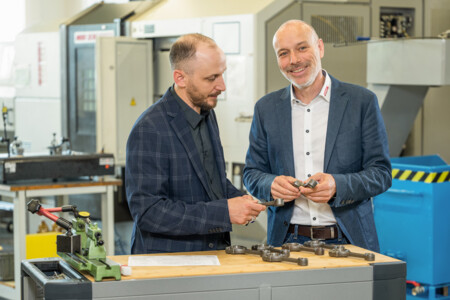Typical mistakes during manual deburring include: damaging the workpiece, operator injuries, and excessive or uneven deburring. However, these errors can be reduced with correct tool usage.




Burrs are small, troublesome metal residues found on the edges of workpieces, whether on bore edges or workpiece surfaces. These burrs are created when material is displaced during the machining of the metal part. Since these sharp edges can affect the functionality and safety of the workpiece, they must be removed. There are two options for removing burrs: either only the burr is removed with a deburring tool, or the edge is provided with a defined chamfer.
In manual deburring, burrs on metal parts are removed using special deburring tools. This involves manually scraping away metal residues from sharp edges or uneven areas. Often, employees perform the same repetitive task for entire work shifts. Removing the burr from the edges improves the functionality and safety of the workpiece. The range of manual deburring tools is extensive, from files to deburring knifes.
Typically, deburring tools consist of a handle and a cutting element, such as a blade or a file. First, the workpiece is thoroughly inspected to identify material residues or sharp edges. Based on the existing burrs, the operator selects the appropriate tool. In use, the operator manually guides the tool along the edge with consistent pressure, scraping away the burrs and simultaneously smoothing the surfaces. The blade is guided along the edge at a steady pace. Skill and experience are required to achieve a consistent result.

Below is an overview of various deburring tools for manual part processing.
Manual deburring differs significantly from other deburring methods. Deburring by hand offers flexibility and simple control but requires manual labor. Instead of a machine, a person performs most of the work. Mechanical deburring methods, on the other hand, use automated tools, which are efficient and precise. Other processes such as electrochemical deburring or thermal deburring often require an additional process step, which is very costly. The various methods all have their advantages and disadvantages. They are selected according to the requirements and the application situation.
Manual deburring by hand has both advantages and disadvantages. Its main strengths lie in flexibility and adaptability, while its weaknesses are in efficiency and consistency.
In practice, manual deburrers are used in various industries, such as Automotive, Aircraft, and also in Medical Technology. These deburring tools are particularly well-suited for deburring small components, as well as when the area to be deburred is difficult to access. In such cases, deburring machines cannot reach these spots. For repair or maintenance work, manual deburring tools are a suitable solution, primarily due to their flexibility and precision.
There are always innovations in the field of manual deburring. Digitization is also making its way into these deburring tools. For example, there are now tool solutions with digital displays or sensors that monitor and optimize the process. Other adaptations also contribute to increasing productivity, enhancing safety, and improving the quality of the workpieces. Thanks to new materials for individual components, deburring tools are more ergonomic and easier to hold, which in turn reduces fatigue. Furthermore, some tools now feature interchangeable cutting heads or multiple cutting operations to meet various requirements.
If an application has burrs that need to be removed, the right process is crucial. Ideally, you should contact a deburring specialist like HEULE, who can provide expert advice. First, the specific requirements for the workpiece and the deburring result are analyzed. Based on this, a deburring solution is recommended, whether it's mechanical deburring, manual deburring, or even electrochemical deburring. The goal is to find the most suitable solution for the specific application. Throughout this process, the experts are available for questions and support.

HEULE's deburring specialists are also happy to advise you on the perfect deburring solution. We are available worldwide, fast and competent.
